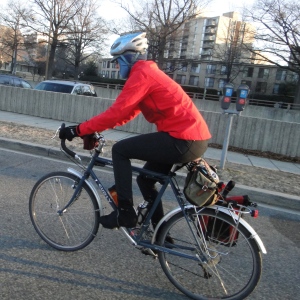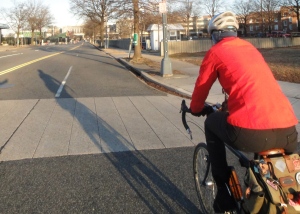It is unusual for D.C. to go into the deep freeze, but it happened this week. We’re experiencing the coldest weather we’ve had since March 2009, according to Capital Weather Gang.
Given that we seldom have snow or ice during the winter months, the cold and wind are the primary deterrents to riding, as opposed to the actual street conditions. Now is the time when commuters test their tolerance of the frigid conditions as well as their gear.
Regarding tolerance for cold, I confess a big fail. I am still riding, but each day I find myself procrastinating my ride to work in the cozy warmth of my home. I don multiple layers and it’s only after I begin to overheat that I reluctantly roll my bike out of the house.
This morning, while parking in my building, a fellow commuter arrived saying, “We’re hardcore. The cold can’t stop us.”
My response? “Maybe not, but I sure whined a lot.”
When Felkerino and I first started seeing each other and riding together, I was much more stoic. Highs in the 20s, but no snow on the ground? Count me in for a century!
This was also my first year of randonneuring, and I was much more committed to getting out in any kind of weather. I thought suffering through the winter cold would pay off if I could avoid discomfort during the spring brevets.
These days, much of my stoicism is gone, though I do force myself out the door to ward off cabin fever and to go to work.
The cold weather is also an excellent opportunity for testing out the winter gear. Perhaps that hat you thought worked in any kind of weather does nothing for you in the cold but give you an ice cream headache. Those thick gloves you thought would keep your fingers toasty? Not so after all.
For my part, I’ve been riding with the following:
Head
- Rivendell wool balaclava
- Little Package medium-weight wool earflap cap
Until this week, I’d been sufficiently warm using a wool gaiter and one earflap cap. This week, though, I found that combination does not cut it. I need extra warmth this combo won’t provide.
The balaclava exposes less of my skin and is thicker than most of the gaiters I own. Combined with an earflap cap, my head stays sufficiently warm. The cap’s brim also gives added protection from the wind.
Since I work out at the gym after work, I want to expose as little of my sweaty head as possible for my return. Frigid air on a damp head is the worst. The balaclava with cap is the way I minimize exposure.
My husband has been using a skull cap, balaclava, and helmet cover combination which works well for him in these temps.
Torso
- Patagonia merino wool base layer
- An additional lightweight wool base layer if I feel like I need it
- Ibex Shak jersey
- Haglof’s Vig Jacket – Soft shell
The torso and head are tricky layering areas. Too many layers and you sweat, which then results in a chill that haunts you the rest of the ride. Not enough and you never warm up, also resulting in unshakeable cold and discomfort.
The layers allow me to make changes along the way so that if temperatures do rise I can remove a layer. A couple days this week, I rode with my wool base layer and Ibex Shak jersey, with an extra wool layer in my Carradice just in case.
The Ibex Shak is a close-knit heavy wool weave that offers plenty of warmth given its weight. Basically, I think every commuter should own a Shak jersey if he or she plans to ride through cold months. They are expensive, but totally worth it (and you can often find them on sale).
The Haglof’s Vig Jacket is a technical soft shell that I purchased this year and am quickly falling in love with. The jacket is wind and water-resistant, lightly lined, and has a two-way zipper, pit zips, ample pockets (including a chest pocket), adjustable cuffs. I find the cut of the jacket flattering. It’s also bright red, which I like for commuting purposes.
I initially purchased this jacket because I wanted a sturdy piece beneath which I could wear one layer and still be warm, but it is going the distance for me on these cold winter rides. The two-way zipper and easily accessible pit zips allow me to adjust for varying temperatures (though if temps are above 45, this jacket would be way too warm). It’s a fantastic piece, and I hope it proves to be a durable one.
Another aspect I like about this jacket is that I can wear it with work pants and it does not look too odd. Usually, I keep a regular wool coat at the office, but I have not done that this year and I have relied on my Haglof’s jacket to get me to and from meetings. No, it is not a business coat, but it will work if I have to go out in the elements and walk to a meeting or want to run and grab lunch with a friend.
Several people in my building have said things to me like, “Are you going to be warm enough in that?” or “I hope you have another jacket.” In fact, once I get going, I’m quite comfortable. A jacket does not need to be bulky or fluffy to be warm. It’s all about wind-proofing and clever layering!
Legs and Feet
- Long underwear (either Ibex or Cuddle Duds)
- Title Nine 1000 Pant
- Serfas booties
- Two pairs of wool socks (one thinner, one thicker, and one knee-high length)
- Diadora mountain shoes (one size bigger than normal to accommodate my socks)
While some riders will commute in cycling or other heavy tights, I prefer to wear regular pants on the commute. Maybe that seems arbitrary, given that I’m also wearing a balaclava and lobster gloves, but some of us have to draw the line somewhere.
Currently, I have been wearing some pants from Title 9 called the “1000 pant.” They are narrow in the leg, which I like because I don’t have to roll up my pantleg to avoid hitting the crank and they also have an articulated knee. These pants are good for days in the 40s, but anything below freezing and they need a boost. Enter long underwear.
Throbbing toes are a bummer. To keep my tootsies warm I purchased a pair of Diadora mountain shoes a few years back (I just can’t give up my SPDs!) in one size larger than the one I usually take. That way, I can wear heavier socks, or even two pairs of socks, and not worry about the shoes feeling too tight. As extra insurance, I wear booties.
Hands
- Polyester liner gloves
- Louis Garneau lobster gloves
You know what’s worse than throbbing feet? Throbbing hands. Ok, maybe it’s a toss-up. They’re both awful.
For temps in the 20s, I have been using my Louis Garneau lobsters, which are less heavy duty and bulky than the Pearl Izumi lobster gloves that I only wear in the most sever of temperatures.
To increase warmth, I use a thinnish pair of polyester liner gloves, too. This is a tip I picked up from Felkerino, and I’m impressed with how much of a difference adding thin liner gloves makes.
So far, my system is working well. I would probably add a little more insulation on the legs if I was going to ride any more than 10 miles one-way, as a little chill sneaks into my quads even with the pants/long underwear combo.
The other parts of my body do well with this layering, even though a kind of primal protest courses through my body when I take the initial pedal strokes out into the frigid mornings. There’s also another protest that manifests in my mind if I look in the mirror when dressed in all my winter garb.
Cold winter days take away any glamour of the commute. Balaclavas, lobster gloves, booties… I mean, really, who likes wearing them? However, when I’m pedaling through the streets with toasty ears, toes, and feet I’m glad I let my winter wardrobe choices be dominated by pragmatism and the desire to be comfortable. And I give myself permission to whine a little along the way.





Comments & questions welcome – moderated for trolls and spam.